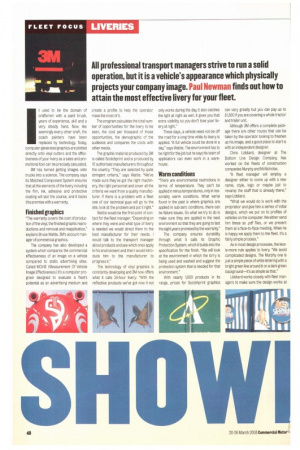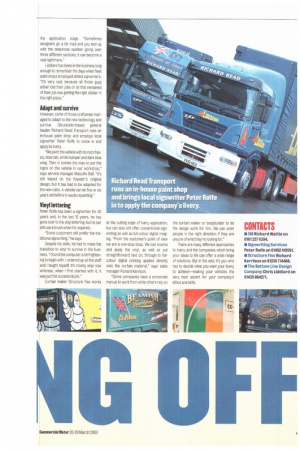All professional transport managers strive to run a solid operation,
Page 40

Page 41

If you've noticed an error in this article please click here to report it so we can fix it.
but it is a vehicle's appearance which physically projects your company image. Paul Newman finds out how to attain the most effective livery for your fleet.
I t used to be the domain of
craftsmen with a paint brush, years of experience, skill and a very steady hand. Now, like seemingly every other craft, the coach painters have been replaced by technology. Today, computer-generated graphics are plotted directly onto vinyl cutters and the effectiveness of your livery as a sales and promotional tool can be precisely calculated.
3M has turned getting images onto trucks into a science. The company says its Matched Component System ensures that all the elements of the livery including the film, ink, adhesive and protective coating will last the course, and it backs this promise with a warranty.
Finished graphics
"The warranty covers the cost of production of the vinyl, the finished graphic reproductions and removal and reapplication," explains Bruce Wattle, 3M's account manager of commercial graphics.
The company has also developed a system which compares the commercial effectiveness of an image on a vehicle compared to static advertising sites. Called MOVIE (Measurement Of Vehicle Image Effectiveness) it's a computer program designed to evaluate a fleet's potential as an advertising medium and create a profile to help the operator make the most of it.
The program calculates the total number of opportunities for the livery to be seen, the cost per thousand of those opportunities, the demographic of the audience and compares the costs with other media.
The graphic material produced by 3M is called Scotchprint and is produced by 10 authorised manufacturers throughout the country. They are selected by quite stringent criteria," says Wattie. "We've made sure they've got the right machinery, the right personnel and cover all the criteria we want from a quality manufacturer. If there is a problem with a fleet one of our technical guys will go to the site, look at the problem and put it right."
Wattle would be the first point of contact for the fleet manager. "Depending on where they were and what type of livery is needed we would direct them to the best manufacturer for their needs. I would talk to the transport manager about products and see which ones apply in his environment and then I would introduce him to the manufacturer to progress it."
The technology of vinyl graphics is constantly developing and 3M now offers what it calls 24-hour livery: "With the reflective products we've got now it not only works during the day, it also catches the light at night as well. It gives you that extra visibility so you don't lose your livery at night."
These days, a vehicle need not be off the road for a long time while its livery is applied. "A full vehicle could be done in a day." says Wattie. The environment has to be right for the job but he says his team of applicators can even work in a warehouse.
Warm conditions
"There are envronmental restrictions in terms of temperature. They can't be applied in minus temperatures, only in reasonably warm conditions. What we've found in the past is where graphics are applied in sub-zero conditions, there can be failure issues. So what we try to do is make sure they are applied in the best environment so that tney are going to last the eight years promised by the warranty."
The company ensures durability through what it calls its Graphic Protection System, which it builds into the specification for the finish. "We will look at the environment in which the lorry is being used and washed and suggest the protection system that is needed for that environment."
With nearly 1,000 products in its range, prices for Scotchprint graphics can vary greatly but you can pay up to £1,500 if you are covering a whole tractor and trailer unit.
Although 3M offers a complete package there are other routes that can be taken by the operator looking to freshen up his image, and a good place to start is with an independent designer.
Chris Liddiard, designer at The Bottom Line Design Company, has worked on the fleets of construction companies Murphy and McNicholas.
"A fleet manager will employ a designer either to come up with a new name, style, logo or maybe just to revamp the stuff that is already there," says Liddiard.
"What we would do is work with the proprietor and give him a series of initial designs, which we put on to profiles of vehicles on the computer. We either send him these as .pdf files, or we present them at a face-to-face meeting. When he is happy we apply them to the fleet. It's a fairly simple process."
As in most design processes, the lessis-more rule applies to livery, "We avoid complicated designs. The Murphy one is Just a simple piece of white lettering with a bright green line around it on a dark green background—it's as simple as that."
Liddiard works closely with fleet managers to make sure the design works at the application stage. "Sometimes designers go a bit mad and you end up with the telephone number going over three different sections; it can become a real nightmare."
Liddiard has been in the business lone enough to remember the days when fleet paint shops employed skilled signwriters. "It's very sad, because all those guys either lost their jobs or all that remained of their job was getting the right sticker in the right place."
Adapt and survive
However, some of those craftsmen managed to adapt to the new technology and survive. Gloucester-based general haulier Richard Read Transport runs an in-house paint shop and employs local signwriter Peter Rolfe to come in and apply its livery.
We paint the vehicle with its red chassis, blue cab, white bumper and dark blue wing. Then in comes the man to put the logos on the vehicle in our workshop," says service manager Malcolm Ball. "It's still based on the founder's original design, but it has had to be adapted for the new cabs, A vehicle can be five or six years old before it needs repainting."
Vinyl lettering
Peter Rolfe has been a signwriter for 40 years and, in the last 10 years, he has gone over to the vinyl lettering; but he can still use a brush when it's required.
"Some customers still prefer the traditional signwriting," he says.
Despite his skills, he had to make the transition to vinyl to survive in the business. "I found the computer a bit frightening to begin with. I ordered up all the stuff and I taught myself It's mostly vinyl now whereas, when I first started with it, it was just the occasional job," Curtain maker Structure Flex works at the cutting edge of livery application, but can also still offer conventional signwriting as well as full-colour digital imaging. "From the customer's point of view we are a one-stop shop. We can source and apply the vinyl, as well as put straightforward text on, through to fullcolour digital printing applied directly onto the curtain material," says sales manager Richard Kerrison.
"Some companies have a corporate manual to work from while others rely on the curtain maker or bodybuilder to do the design work for him. We can point people in the right direction if they are unsure of what they're looking for."
There are many different approaches to livery and the companies which bring your ideas to life can offer a wide range of solutions. But in the end, it's you who has to decide what you want your livery to achieve—making your vehicles the very best advert for your company's ethos and skills.








































































































































































